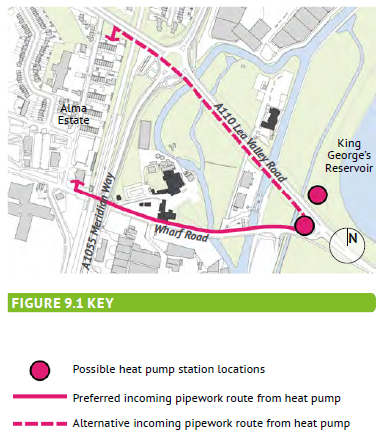
9.1.1 Development in North East Enfield is expected to deliver a significant number of new homes and jobs over the next 15-20 years. This presents an opportunity to provide a place which promotes sustainable lifestyles through well designed buildings and spaces, and that help to enhance local biodiversity, use of energy and water efficiency, manage the impact of waste, mitigate the impact of climate change and promote walking, cycling and the use of public transport.
9.1.2 The Core Strategy seeks to achieve wide economic and environmental sustainability simultaneously and recognises the important interrelated health benefits of welldesigned neighbourhoods, high quality housing, access to employment opportunities, access to open space and access to shops and services. The DMD sets out specific requirements in relation to energy efficiency and sustainability. There is no need for this AAP to repeat higher level policy, and so this chapter focuses on setting out policy in relation to areaspecific issues - in particular, the Lee Valley Heat Network.
9.2.1 The Council working in partnership with neighbouring boroughs of Haringey and Waltham Forest, the GLA and NLS A have undertaken a study on the feasibility of the Lee Valley Heat Network, [LVHN] July 2011. It addresses how planning the future of energy provision in the subregion could deliver economic benefits for local residents and businesses including helping to reduce fuel poverty and stability in energy costs.
9.2.2 It demonstrates that there is a unique opportunity to deliver commercially sustainable decentralised heat network that would put the Upper Lee Valley at the forefront of energy production in London. The vision is to combine strategic energy assets and develop them to become a source of lowcost, low-carbon heat where local waste streams represent a significant renewable fuel resource.
9.2.3 The Heat Network has the potential to deliver cost-competitive, low-zero carbon energy supplies, support job creation, reduce overall carbon emissions, facilitate the transition to the low carbon economy, and support development in a coherent, unified way. The Upper Lee Valley Opportunity Area Planning Framework (ULVOAPF) identifies the Edmonton Eco Park is the preferred location as the supply hub for the Lee Valley Heat Network, where best use can be made of existing generating facilities.
9.2.4 The London Boroughs of Enfield and Haringey have followed up the initial feasibility study with a more detailed technical study, the Lea Valley Heat Network - Alma Estate Lake Loop Heating (Dec 2013). This study investigates the feasibility of using a heat pump to extract heat from the King George V reservoir via a lake loop to provide the regenerated Alma Estate with heat. Power would be provided via a CHP unit provided as part of the Alma Estate Regeneration. The study recommends that, on the basis of both financial and environmental performance, the lake loop is the preferred option. There are a number of risks to the success of the project, and an approach to mitigating these is set out in the report. It is an ambitious scheme, which needs to be able to stand alone, but also have the capacity to expand and integrate easily with neighbouring London heat networks.
Policy Context for Chapter 10: Sustainable Energy |
|
London Plan |
Policy 5.5 Decentralised energy
networks Policy 5.6 Decentralised energy in
development proposals Policy 5.7 Renewable energy Policy 5.8 Innovative energy technologies |
Upper Lee Valley Opportunity Area Planning Framework (July 2013) |
Objective 6 |
Core Strategy (Adopted Nov 2010) |
Policy 20: Sustainable energy use and energy infrastructure |
Adopted Development Management Document (November 2014) |
Policy DMD50: Environmental
Assessment Methods Policy DMD51: Energy Efficiency
Standards Policy DMD52: Decentralised Energy Networks |
Other Sources |
National Planning Policy Guidance Enfield Renewable Energy and Low
Carbon Study (AECOM), 2010 Lee Valley Heat Network Feasibility
Study Pre-feasibility Study of the Viability
of a Decentralised Energy Network
in the context of the Upper Lee
Valley (Parsons Brinckerhoff ), 2011 Enfield 2020 Sustainability Action Plan |

Enfield Power Station
Figure 9.1: Alma Estate District Heating Options

9.3.1 Enfield Power Station is located at the northern end of the Brimsdown Industrial Estate adjacent to the River Lee Navigation. It is a natural gas fired power station operated by EON. At present waste heat from power generation is expelled into the atmosphere at 40 degrees celsius via air cooled condensers. As part of the initial feasibility study into the LVHN, options have been identified for taking waste heat from the power station and preliminary discussions have been held with EON. As yet, there is not certainty that the power station could provide heat as well as power.
9.3.2 The power station is scheduled to operate until 2023, at which point EON will decided whether to:
9.3.3 The feasibility study recommend that any new power station at Enfield should be designed to operate in CHP mode, although it should be able to also operate in power mode only to allow flexibility should heat demands not meet expectations. The study stresses the importance of ongoing communication with EON.
Policy 9.1: Sustainable Energy A coordinated approach to sustainable energy is required within North East Enfield to deliver the carbon reductions required by higher level policy. Proposals within North East Enfield will need to demonstrate compliance with the London Plan and Enfield’s Local Plan’s policies on energy and sustainability ensuring that development integrates: energy efficiency measures, decentralised energy systems; and renewable energy technologies.
The Council will:
Changes in energy production must ensure no net addition to air pollutant emissions and, where possible, a reduction in such emissions. The implementation of the LVHN will need to ensure no direct or indirect impacts on the Lee Valley biodiversity interests or interests of other European sites.
|
< Previous | ^ Top | Next >